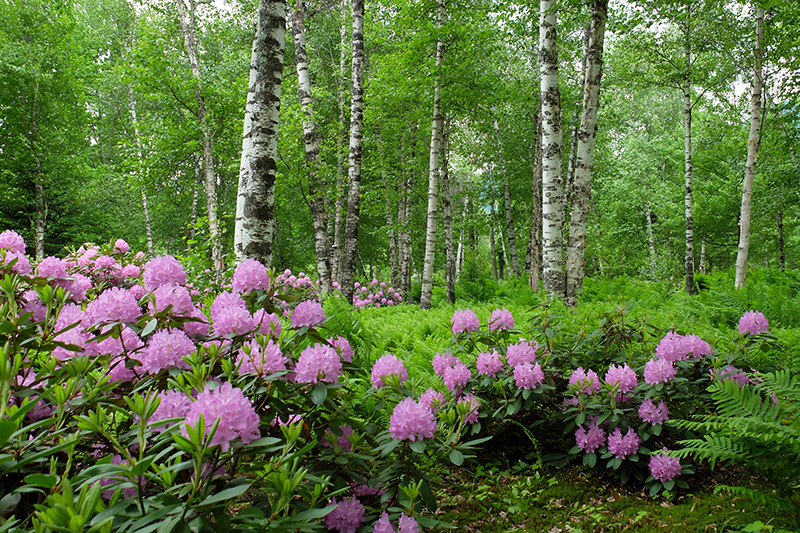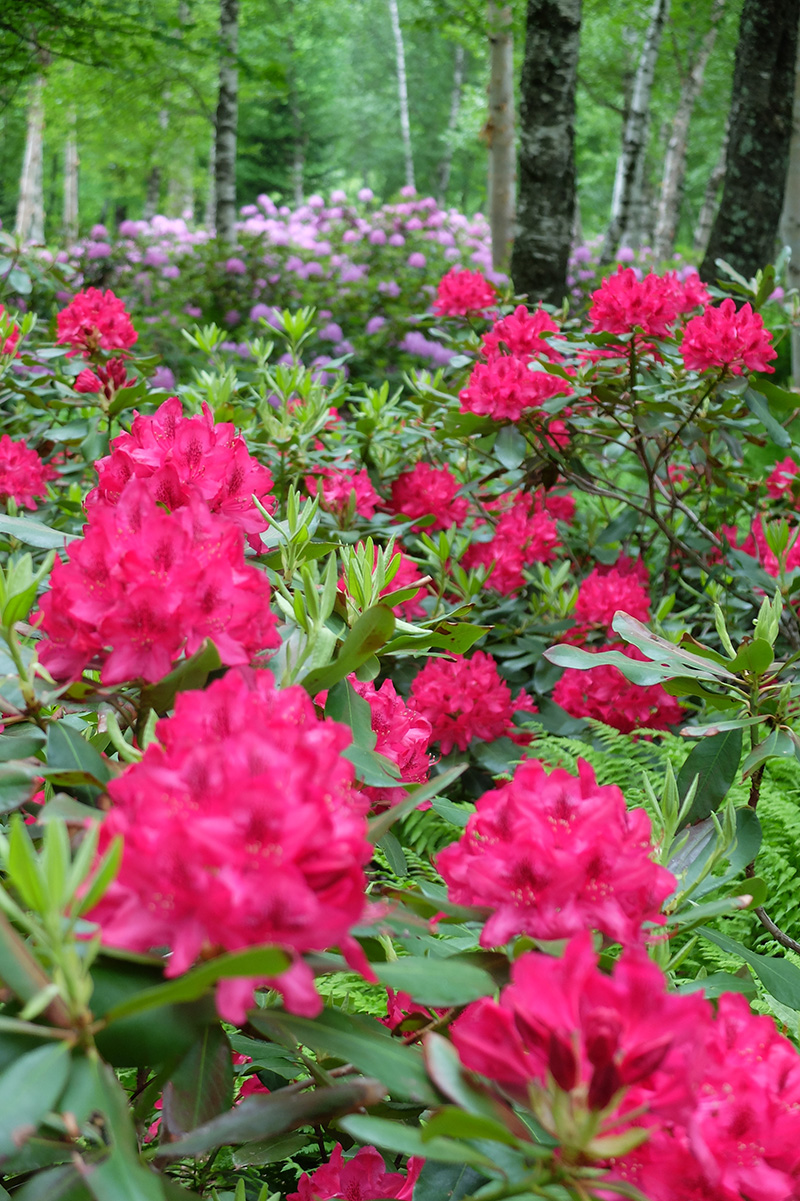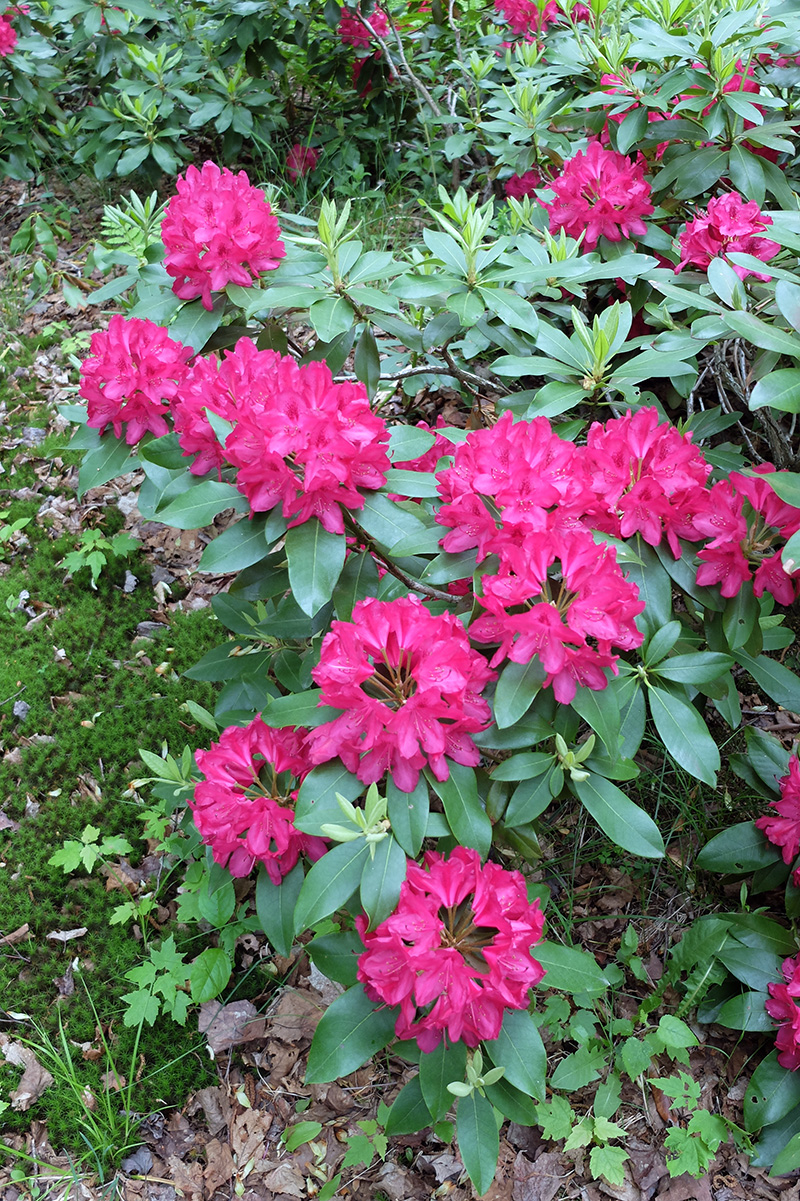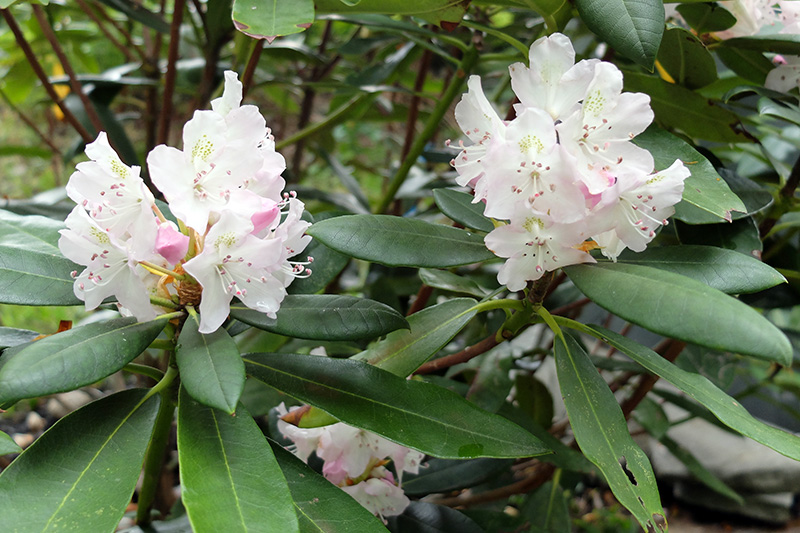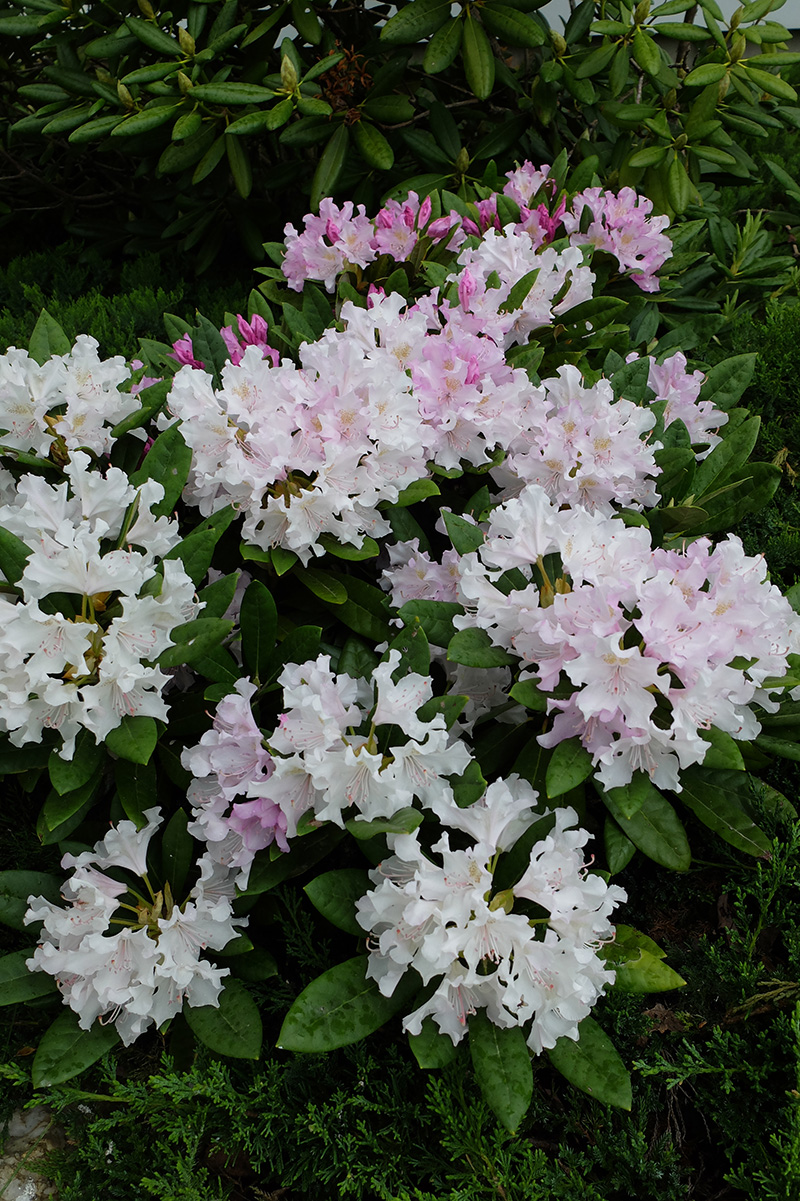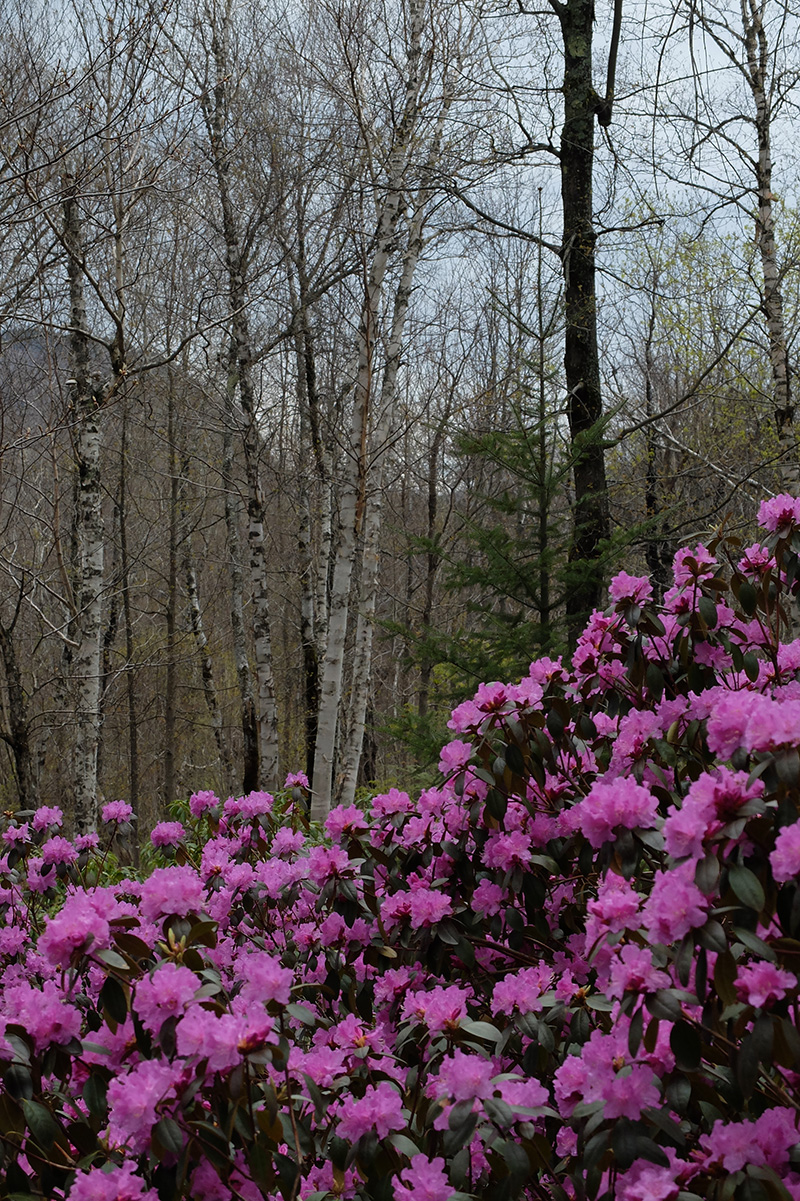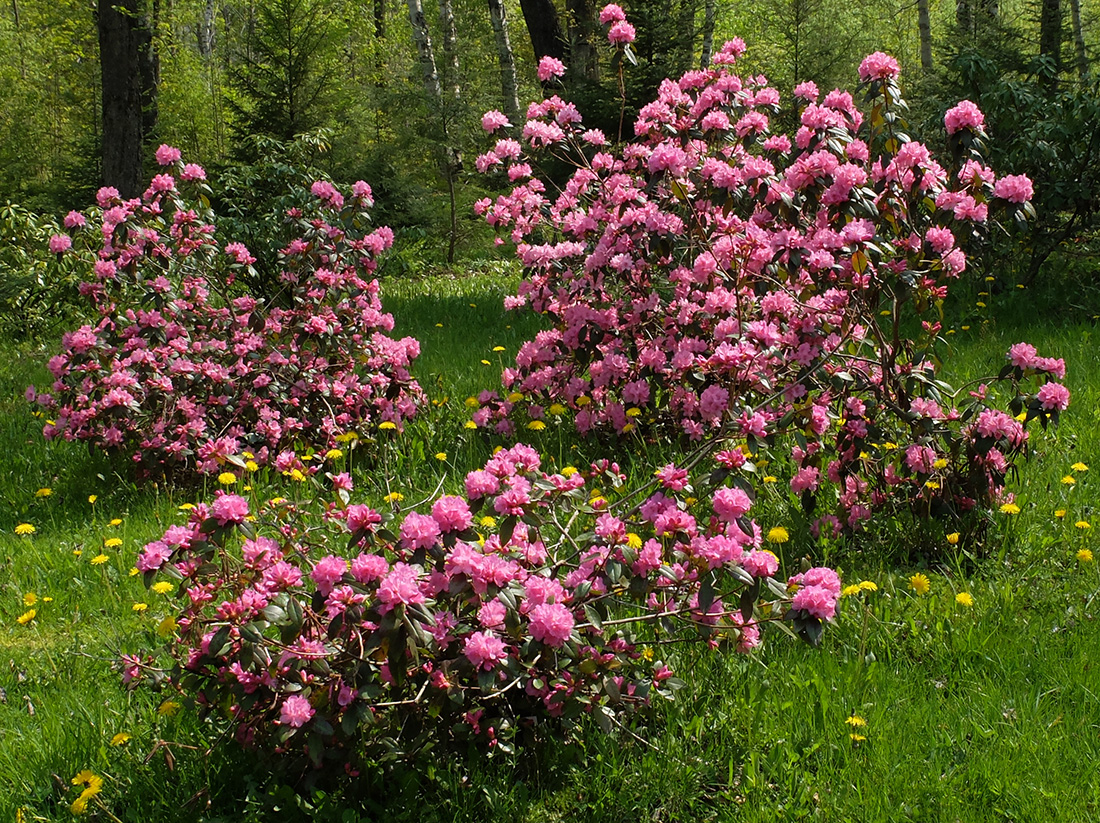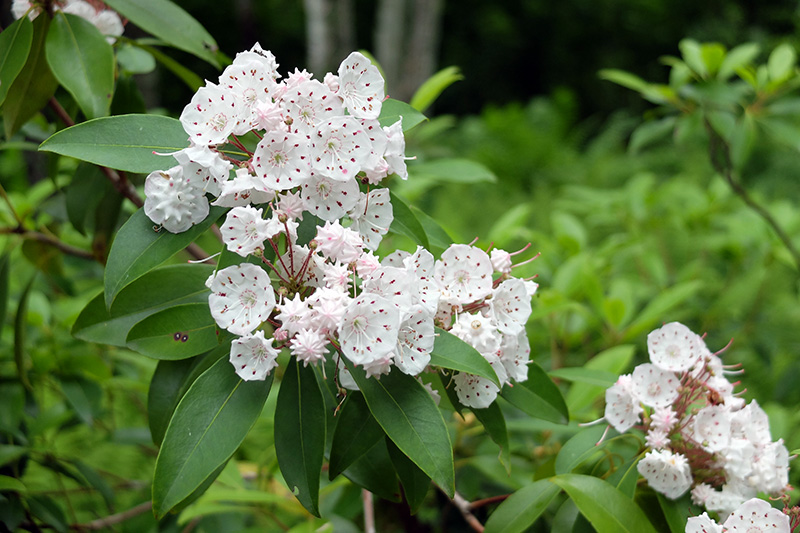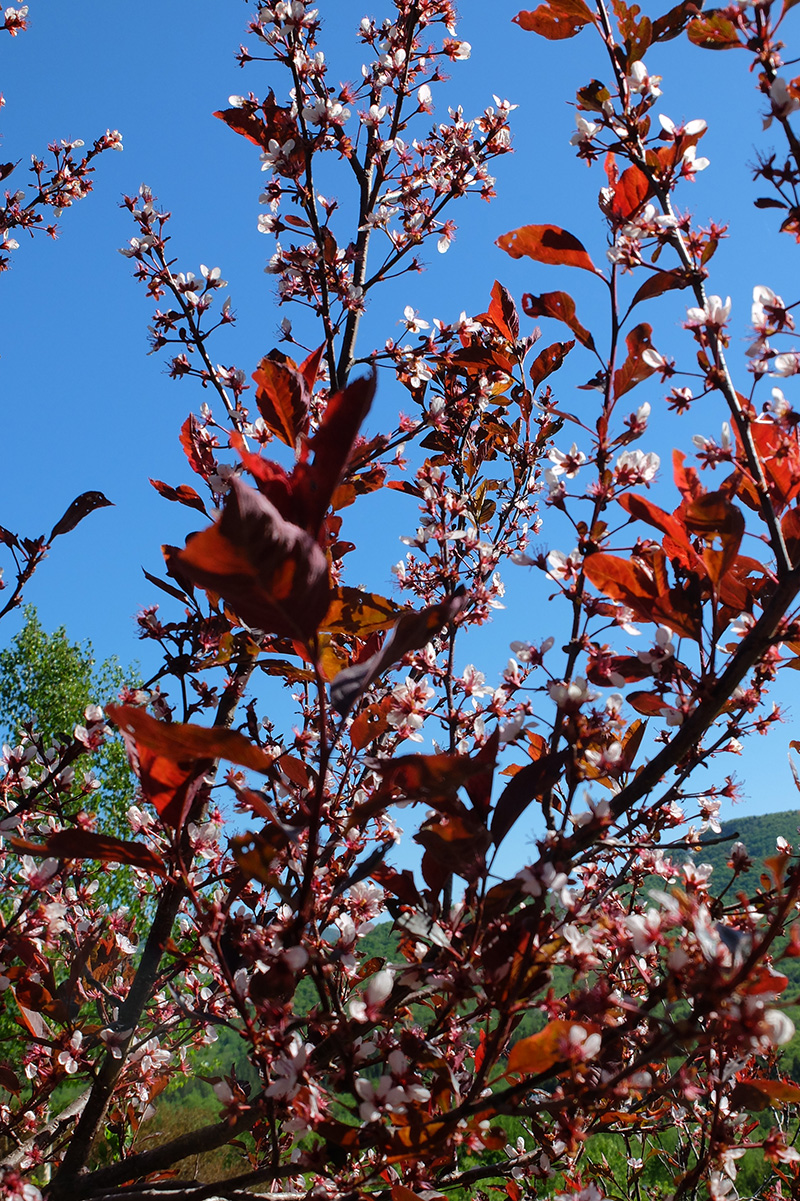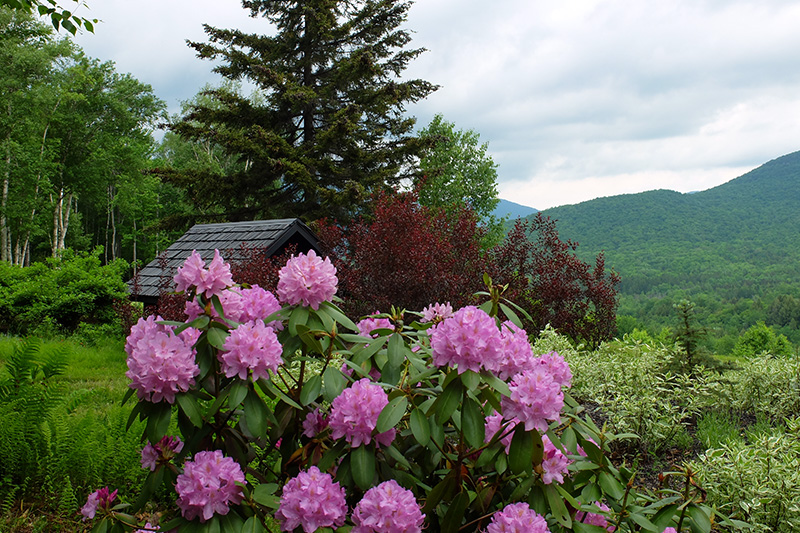
A sweep of ‘Roseum Elegans’ rhododendrons with the Green Mountains rising in the background
How the Birchwood Was Created: History of the Garden Since 2009
The Birchwood is the second large woodland garden (after Evergreen) created by the landscape designer Robert Gillmore. This is his account of how it was made:
![]()
To date, the history of the Birchwood has been a story of good luck.
Eileen and I had long admired the site, and in January, 2009, we had our first of several bits of luck: The 45-acre lot unexpectedly came on the market, and we were able to buy it.
Our second stroke of luck was the land itself. It includes precipitous slopes on both sides of Wade Brook. These long, wide bluffs help create the garden’s dramatic views (described below) of the highest mountains in far-northern Vermont.
The parcel also includes about seven nearly level acres on the Hazen’s Notch Road, which we immediately christened “the Birchwood.” These acres—the heart of the garden—possess superb natural ornamental assets (including its namesake white and gray birches) that are now among the signature plants in the garden.
These include large, luxurious carpets of hairy-cap moss (Polytrichum commune) and sweeps of ferns that now cover more than half of the garden.
Even better, a majority of the ferns are Thelypteris noveboracensis, or New York fern. This is a neat, low, garden-worthy plant. Its fine foliage resembles the fronds of hay-scented fern (Dennstaedtia punctilobula), and it grows in solid, compact drifts. It’s one of nature’s most elegant ground covers, and in the moist soil of the Birchwood it spreads quickly and easily.
Like the mosses, the fern’s large, low drifts of foliage are perfect settings for the birches and evergreen shrubs (described below).
In other words, like many naturalistic gardens, many of the Birchwood’s most important features were already in place when Eileen and I acquired the land. That, of course, was why we had coveted the site for so many years.
![]()
The Birchwood is also blessed with a superb 180-degree view of the Green Mountains—that was our third bit of luck. The vista includes the 3,858-foot Jay Massif, whose two major summits—Big Jay and Jay Peak—are the two highest mountains in far-northern Vermont. The rest of the prospect, viewed from west to east, includes the deep cleft of Jay Pass, to the right of the Jay Massif; the long, rolling ridge of Buchanan Mountain; Sugarloaf Mountain, whose southern escarpment is the precipitous north wall of Hazen’s Notch, the deep, narrow, 1,780-foot pass through the Green Mountains; and the bulky, 3,223-foot Haystack Mountain—the third-highest summit in the view—which forms the south wall of Hazen’s Notch.
This prospect is dramatic not only because of the mountains, but also because of the deep valleys below them. The northern edge of the Birchwood plunges several hundred feet into the valley of Wade Brook. From the bottom of this valley, the closest mountains—Buchanan, Sugarloaf and Haystack—sweep up sharply, rising 2,000 to 3,000 feet in only two to three miles. Farther away, the Jay Massif rises as much as 3,000 feet up from the valley of Jay Brook in less than four miles.
The Birchwood’s awesome mountain-and-valley views are an extraordinary example of what landscape designers call borrowed scenery. Thanks to this dramatic landscape—which we do not own but merely “borrow”—the Birchwood, paradoxically, is much larger than seven acres. It’s actually more than 10,000 acres! That’s because, unlike a house lot, for example, a garden isn’t only a legal entity; it’s a visual one: It isn’t only the landscape you own. It’s everything you can see from the land that you own.
Gardening by Subtraction
To transform the Birchwood into a woodland garden, the first step we took was the same one I take when I transform any woodland into a forest garden: gardening by subtraction. Subtraction enhances a woodland’s ornamental assets—such as impressive trees and great mountain vistas—by removing anything that obscures, or detracts attention from, or otherwise clutters up the views of those features. Subtraction also enhances ornamental assets by making them look larger and more impressive (see below). It strengthens the total landscape by leaving only the most beautiful elements in place and getting rid of almost everything else.
Example: For the Birchwood’s mountain view to be as dramatic as possible, one needs to see not just the mountaintops, but all of the vast steep slope of the mountains rising from deep in the valley of Wade Brook. To open up this view, trees on the precipitous north slope of the Birchwood had to be cut down (and they’ll need to be cut again when they grow back).
This is another illustration of the idea that great views often don’t just happen—they’re not just happy accidents of nature. They’re enhanced.
The cutting not only enhanced the view. It also created 5 acres of excellent wildlife habitat: The tangle of downed tree trunks and branches provides protection and nesting sites for birds and small mammals; and the newly created clearing allows the emergence of many new plants—everything from berry bushes to hardwood saplings—that provide food for many birds and animals.
![]()
We also needed to subtract trees to enhance the heart of the Birchwood itself. The essence of the Birchwood is its seemingly unending crowd of dozens and dozens of white birches: a stunning mass of white tree trunks. To make this feature as powerful as possible, we needed to make it as white birch-like as possible: to remove anything that reduces the total amount of whiteness in view. That’s why we removed all the smaller maples and other non-birch hardwood trees in the grove.
We left only the largest non-birch hardwoods alone because they were the only non-birch trees with enough presence to be attractive. The paradox of deciduous trees is that, even though they’re the largest plants in a garden, their trunks are often less than 1 foot wide—narrower than most shrubs, which are usually at least 2, 3, or 4 feet wide. Most of the width of hardwood trees is in their crowns, which spread 10, 20, 30 or more feet. Hardwoods are impressive in relatively open gardens because, when they’re standing alone, you can see the entire tree—not only the relatively skinny trunk but the wide, impressive crown.
In the woods, of course, you seldom see an entire tree clearly because trees almost never stand alone; they’re massed. Their crowns disappear into the rather amorphous woodland canopy, which is not as striking as features closer to the ground.
What’s more, when you walk through a woodland garden, you tend to look straight ahead or slightly lower, not at what’s several yards above your head. That means you see mainly what’s at or below eye level: mostly shrubs, ground covers . . . and the trunks, not the canopies, of trees.
Unfortunately, most tree trunks aren’t impressive unless they’re big—at least a foot in diameter—and they don’t get big until the tree gets old—at least 15 or 20 years or more. (And, all things equal, the older they are, the grander they become. For only when old do they develop such impressive sculptural features as deeply furrowed bark and wide-flaring roots.)
Happily, the few spruces, balsam firs and other needle evergreen trees in the Birchwood have no such limitation. Unlike hardwoods, they’re usually attractive at any age. That’s because they acquire their “Christmas-tree” shape—a dense, wide-spreading cone of thick evergreen branches—when they’re very young. They’re interesting accents, and a welcome source of year-round dark green color, even when they’re no larger than small shrubs. And as they grow larger, they’ll become ever more imposing with every passing year. Needless to say, we left virtually every one alone, and we’re grateful for every one.
(Like evergreen trees—but unlike most hardwoods—white birches don’t need to get old before they’re lovely attractive. They’re beautiful as soon as their bark turns white.)
![]()
Gardening by subtraction also requires removing all dead or dying trees (including, in this case, a few birches). This not only gets rid of often-unsightly plants; it’s also preemptive: it removes dead trees before their branches break or their bark peels off, which makes them even less attractive; or before they fall down and crush shrubs (see below) or other valuable plants.
![]()
To help remove the site’s unwanted trees, I put up posters saying: “FREE FIREWOOD / Yours for the cutting.” Another piece of our great luck was that the posters attracted several men in the area who regularly harvest trees. They were happy to cut and take away all but the smallest trees without charge. They were actually able to sell some of the larger, straighter logs for lumber, which, of course, is more valuable than firewood. Fortuitously, the non-birch species I wanted removed—mainly maples, but also beeches, cherries, and ash—make either fine lumber or good firewood, while the mostly gray birches I wanted left alone do not. In other words, the trees they wanted were the very trees I wanted gone!
The trees they didn’t want—seedlings and small saplings, all way too skinny to interest any logger—I removed myself (see below).
I also needed to weed out a few brushy, woody shrubs such as the prolific wild spirea known as hardhack (Spirea douglasii) as well as various herbaceous plants. None of these were especially attractive—few, if any, are planted in ornamental gardens—and many were sun-loving species doomed to become ever more scrawny and unattractive. This is because they were on the wrong side of garden history: As the canopies of the remaining trees grew ever wider and thicker, they would make the garden ever more shady, and the sun-loving species would receive less and less life-giving light. Especially in the Birchwood they contributed only clutter. Like the smaller hardwood trees, they didn’t improve the composition; they only messed it up.
![]()
Much of this subtraction is best done on hands and knees. That’s where you can most easily see the many little stems that need to be removed and where you can most easily reach them.
The smallest unwanted plants weren’t cut; I pulled them out, roots and all. If you can extract enough of its root, the plant will never bother you again. But if you simply cut it, it will probably grow back and you’ll have to attack it again . . . and again.
I uprooted the very smallest plants by hand. These included most herbaceous perennials, tiny woody brush, and tree seedlings thinner than a quarter-inch. (The stronger and/or more determined you are, the larger the plant that you can extract with your bare hands.)
![]()
Plants too big to pull out by hand were removed with a Weed Wrench. This valuable tool is a weighty, L-shaped steel apparatus that can uproot shrubs and seedlings as much as two inches thick.
A Weed Wrench has two sections: the bottom, or foot, of the “L,” which is about 10 inches long and rests on the ground; and a long vertical shaft, which adjoins the heel of the foot at a right angle. The tip, or toe end, of the foot has a powerful namesake wrenchlike pincer that grabs the stem of the plant. As you pull farther and farther back on the vertical shaft, the Weed Wrench pivots on the heel of its foot, and two things happen at once: The pincer (conveniently) grips the plant tighter and tighter while the shaft uses its leverage to gradually pull it out of the ground.
If you pull back the shaft about 45 degrees, for example, the tip of the foot usually lifts the plant about four inches out of the ground—often enough to fully extract a small seedling from the earth. Pull the shaft back 90 degrees—i.e., all the way down to the ground—and the foot lifts the plant another three or four inches—often enough to uproot a larger seedling.
If the earth still doesn’t give up the plant, you can reattach the Weed Wrench to a lower part of it—perhaps a major root that’s now above ground—and pull the shaft back again. You can keep repeating the process until the plant is finally uprooted. Or until it’s loose enough to yank it out by hand.
![]()
Larger seedlings and most saplings are too big to pull out of the ground, even with a Weed Wrench. Unfortunately these have to be cut.
My favorite grooming saw is a pruning saw. Its big, jagged teeth tear easily through trees as thick as four, five, or even six inches at the base.
I cut trees right next to the ground—the blade actually touches the dirt. This ensures that the stumps either disappear entirely or can easily be buried under just a shovelful of dirt.
Making stumps disappear is essential, not only because they’re inherently unattractive, but also because any stump, no matter how small, spoils the natural look of a garden.
Sawn stumps look unnatural—because they are. That’s because there are no stumps with smooth, flat tops in nature—indeed no sawn wood at all. (The closest natural thing to sawn stumps are trees that have simply broken off near the base, leaving a splintery stump behind; but they’re even less attractive than sawn stumps.)
You don’t need to worry that dirt will dull your saw. It will, of course, but only gradually, and the blade can be replaced; it’s one of the very affordable costs of woodland gardening. (I also asked the men removing the larger trees to cut them as close to the ground as possible.)
![]()
Many of the Birchwood’s unwanted plants were ferns that were larger and coarser than New York ferns—mainly cinnamon fern (Osmanda cinnamomea), interrupted fern (Osmanda claytoniana), royal fern (Osmanda regalis), and ostrich fern (Matteuccia struthiopteria). Their size and complexity make them interesting accent plants, and, like virtually every fern, they flourish in moist, shady sites like the Birchwood. But in many places they were unwelcome. The problem, as realtors like to say, was location, location, and location: Many of them were growing within drifts of New York fern, so they spoiled the latter’s otherwise perfect, gardenlike sweeps.
One of the biggest but most satisfying tasks of gardening by subtraction in the Birchwood was subtracting large ferns from masses of New York fern. With every unwanted fern weeded out, the carpets of New York fern grew steadily more perfect and therefore more impressive. The results, in fact, were often breathtaking. And I never ceased to marvel at the fact that all we had to do to make this happen was simply to give the New York ferns a chance to do their marvelous thing. More than 100,000 square feet of beautiful ground cover—easily thousands of dollars worth of ornamental plants—were simply magnificent gifts of nature, ours only for grooming them.
So prolific are the New York ferns that they spread over nearly half the Birchwood—and would actually cover even more of it if we let them.
Unlike the New York ferns (and the mosses), the larger ferns weren’t neat, low ground covers that nicely offset the garden’s trees and shrubs. On the contrary, they’re so big—as much as four feet tall—that they competed visually with the trees and especially with the rhododendrons and other shrubs. Like other unwanted plants, they added only clutter to the garden: They made it look busy.
I did leave a few of the most attractive large ferns as accents, but only in the rare locations where they stood alone and didn’t interfere with views of other plants.
I did leave one rare, nearly solid sweep of especially large ferns growing on the highest part of the Birchwood. It made the spot seem even higher, and thus more dramatic, and it nicely separated one part of the garden from another.
![]()
Besides removing trees and other plants from the Birchwood, I also needed to prune many of the trees that remained.
I cut off all dead or broken branches for the same reason we got rid of dead trees: They’re unattractive and will eventually fall down anyway.
I also removed all branches growing less than about eight feet above the ground for the same reason we cut down trees in the Birchwood: to open up views of the garden and to remove anything that obscures or distracts attention from its most ornamental features, such as its white birches and evergreen shrubs.
This pruning also had the effect of enhancing the birches by emphasizing their larger and therefore more colorful white trunks instead of their smaller and less colorful branches.
It also enhanced the few non-birch trees by emphasizing their larger, more interesting trunks instead of their much smaller and therefore less impressive branches.
![]()
All this pruning and weeding produced big piles of plant debris, and of course we had to get rid of it. We also needed to dispose of tons of dead and rotting trees and branches that had accumulated on the forest floor over many years.
Happily, we didn’t have to burn it or haul it away in trucks. Yet another piece of our good luck was the steep slope on the northern edge of the Birchwood: All the plant waste created in the garden could simply be dumped over the edge, where it would never be seen again (but would create wildlife habitat before it eventually rotted away).
![]()
Quite unlike Evergreen, which boasts immense handsome boulders, the Birchwood has almost no natural rock sculpture.
A grand exception to that rule is a beautiful broad, smooth, curvy ledge—about 20 feet by 20—on a slope in the meadow on the north side of the garden.
Before I uncovered it, the ledge was—or appeared to be—just a small but attractive boulder, barely three feet wide, poking above the grass. (Although even at that size, it was one of the largest rocks on a mostly rockless site.)
The boulder was a wide pyramid, pointed at the top and sloping gently on all sides, rather like a handsome miniature mountain. I wondered how big the rock really was and how far underground it extended. I was hoping that it was like an iceberg: just the tip of a much larger rock.
I began digging grass away from the rock. Where the turf was thin, it rolled easily and cleanly away from the rock, revealing an ever-larger piece of bedrock. I was delighted to discover that the rock was even more than I had hoped for: It was part of an enormous ledge that spread out in every direction.
I dug and dug and dug some more until all the ledge near the surface was exposed. After I had removed big piles of dirt and grass, what remained was an impressive piece of natural granite art: broad, smooth ridges divided by long, deep, narrow clefts.
Next I hired an excavator to scrape away the turf around the ledge. By lowering the grade around the rock, I made it more visible, more prominent, more impressive.
In the excavated area around the ledge and in the clefts within it, I added three dozen Sargent junipers (Juniperus chinensis ‘Sargentii’). These thick, handsome evergreens will nicely fill the concavities in the rock, and they’ll spill over its smooth convex surfaces, which will nicely offset their dark green needles.
The entire rock-and-evergreen composition is more than 30 feet long and wide. It’s a dramatic example of gardening by subtraction. The ledge was a huge buried natural treasure, a great gift of nature that needed only to be unwrapped.
![]()
Another example of gardening by subtraction is a smooth ledge on the edge of a slope in the northern part of the Birchwood. When I started uncovering the rock, it was a modest three feet by four and about six inches higher than the ground. It was attractive enough and a nice platform from which to view one of the Birchwood’s best views: a Green Mountain panorama stretching from Sugarloaf Mountain, to Hazen’s Notch, to Haystack Mountain. But it was hardly sublime.
Like the giant ledge in the meadow, however, I thought there might be more rock here than met the eye. Happily, I was right.
I began by digging away the layer of turf—no more than six inches deep—on top of the rock. When I was done, the rolling, nearly horizontal surface of the ledge was almost 15 feet wide and 20 feet long. Its visible surface had grown from about 12 square feet to about 300!
The sides of the ledge plunge steeply into the earth, rather like the hinged, dropped leaves of a table. On the south and west sides of the rock, the forest floor is nearly as level and almost as high as the rock; digging here would have uncovered no more ledge. The north and east sides of the rock were different: Here the grade dropped steeply for as much as two yards, and, like the flat surface of the rock, the steep slope was covered only by a rough layer of topsoil and turf, usually no more than eight inches thick. I dug it all away, and the newly exposed ledge fell in sharp concave and convex curves and short, sheer cliffs. The northern and eastern slopes of the rock are as precipitous and exciting as the top is flat and underwhelming. The entire ledge was now a captivating piece of natural sculpture.
I framed the big rock with a fringe of Microbiota decussata. Known as Russian arborvitae and Siberian cypress (and also Russian cypress and Siberian arborvitae), the juniperlike evergreen ground cover usually grows less than a foot high and spreads six feet or more. Unlike junipers, however, it’s shade tolerant; so, unlike many needle evergreens, it’s suitable for woodland gardens like the Birchwood. In time, the Microbiota will fill in the spaces between the ledge and the surrounding trees and shrubs, and its feathery foliage will drape nicely over the rock.
The only cavity in the top of the ledge was a small pocket, less than two feet long and eight inches deep. I filled it with as much loam as it would hold and planted it with Vinca minor, the shade-tolerant ground cover with periwinkle-colored flowers and glossy evergreen leaves. The bright patch of green decorates the broad ledge and helps direct the path across it.
Making rocks “larger” and therefore more striking is also explained on page 93 of The Woodland Garden and pages 88 and 89 of Beauty All Around You: How to Create Large Private Low-Maintenance Gardens, Even on Small Lots and Small Budgets.
![]()
Finally, we had to remove one more thing from the site: a partially built house left behind by its former owners. To get rid of it, we put up posters saying: “FREE: New unfinished 2-story house. . . . Must be moved or completely taken down. . . . Excellent opportunity for builder/handy person.”
Yet another bit of luck was that we found two carpenters—father and son—who, like the men who removed our unwanted trees without charge, took down the house, piece-by-piece, for free. They wanted the framing lumber, windows, doors, and other materials to build a house for the son. Like the free removal of the trees, that sort of thing happens a lot in the Northeast Kingdom.
Planting
When the gardening by subtraction was finished, the Birchwood was clean, open, parklike. The sweeps of birches, the carpets of moss, and the vast drifts of New York ferns had been made as striking as they could possibly be made. The Birchwood was never more of a birch wood.
The newly groomed garden was yet another demonstration that gardening by subtraction can make a woodland immensely more attractive all by itself—without adding anything, not even a single plant. It demonstrated the paradox that simply taking things away from a garden can add so much to it.
But, of course, the Birchwood was not complete. Its birches and large specimen trees formed the walls and the ceilings of its outdoor rooms, and its often-exquisite ferns and mosses carpeted its floors. But these rooms looked a bit empty because there was not a lot in them; that is, there was almost nothing in the middle layer of the garden.
Worse, the Birchwood’s plants had no year-round presence other than its trees and mosses, because nearly all its ferns were herbaceous—they disappeared in late fall and didn’t reappear until spring.
What the garden needed was medium-size plants—that is, shrubs—to furnish its rooms, and specifically evergreen shrubs, whose foliage would make the Birchwood interesting all year long.
![]()
What kind of evergreen shrubs? Most cold-hardy needle evergreen shrubs (pines, spruces, junipers, etc.) don’t do well in shade, and none are especially colorful, because they don’t produce visible flowers. In contrast, many broadleaf evergreen shrubs tolerate shade—many actually prefer light shade—and many produce colorful flowers. Furthermore, the blossoms of rhododendrons and mountain laurel (Kalmia latifolia) are generally more colorful than the flowers of any other cold-hardy broadleaf evergreen shrub (such as andromeda (Pieris species), holly (Ilex species), and leucothoe).
I planted mainly large-leaf rhododendrons, not mountain laurel, in the shadier parts of the garden because I find that these rhodies tend to flower better than laurel in the shade.
I chose mainly Catawba varieties (Rhododendron catawbiense) because they’re among the most colorful large-leaf rhodies—their large flower trusses can reach six inches across. They’re also among the hardiest rhododendrons—they’ll survive in Zone 4, whose average minimum temperature is -30 degrees Fahrenheit. (The Birchwood seldom gets colder than -25 degrees.)
We planted almost 600 Catawba rhodies, including sweeps of “ironclads,” so called because they’re the toughest varieties of all. We chose 216 ‘Roseum Elegans,’ which produce dark rose flowers; 90 ‘English Roseum,’ which sport rose-pink blossoms; 156 ‘Nova Zembla,’ which bear red flowers; 22 ‘Lee’s Dark Purple’ and 43 ‘Purpureum Elegans,’ both named for their purple blooms; and 36 ‘Roseum Pink,’ named for their pale pink flowers. In Montgomery Catawbas bloom in early June.
We also planted about 40 rosebay rhododendrons (Rhododendron maximum) and 47 Rhododendron maximum ‘Roseum.’ Rosebay’s white or pinkish white blossoms are not as prolific or as showy as Catawba flowers, but they provide welcome blossom color in mid- to late June, after most other shrubs have already flowered. ‘Roseum’ blooms a bit earlier and—even though it’s a variety of Rhododendron maximum—its red-pink flower trusses look more like Catawba’s.
For still more variety, we added 11 ‘Hellikki,’ a cold-hardy Finnish rhody that sports dark red flowers and also blooms in early June.
![]()
The Birchwood is a moist, lightly shaded woodland—ideal for rhododendrons—but it’s also exposed to often-fierce winds. That’s why, in the more exposed northern and western edges of the garden, we planted 100 Rhododendron yakushimanum ‘Ken Janeck’ and 20 ‘Pohjola’s Daughter,’ a Finnish variety. Both grow no more than three or four feet high, so they’re less susceptible to damage from prevailing northwesterly winds. Both sport white blossoms and, like the Catawba rhodies, they bloom in early June.
![]()
In clearings and other relatively bright parts of the garden we added sweeps of little-leaf rhodies, which flourish in sunlight and flower prodigiously in mid-spring—about a month before the Catawba rhodies. We planted 89 of the justifiably popular P. J. M.s, which produce purple pink flowers, as well as two related varieties: 8 ‘Aglo’ and 16 ‘Olga Mezzitt,’ which sport pink blossoms.
![]()
In clearings and other relatively bright parts of the garden we added sweeps of little-leaf rhodies, which flourish in sunlight and flower prodigiously in mid-spring—about a month before the Catawba rhodies. We planted 89 of the justifiably popular P. J. M.s, which produce purple pink flowers, as well as two related varieties: 8 ‘Aglo’ and 16 ‘Olga Mezzitt,’ which sport pink blossoms.
Like little-leaf rhodies, mountain laurel flowers best in full sun, but it also tolerates shade, so we planted two sweeps—39 shrubs in all—in lightly shaded areas. Laurel unfurls its exquisite white flowers in mid-June—after the Catawba rhodies flower but before the Rhododendron maximum blooms.
All together, the Birchwood’s broad-leaf evergreen shrubs create flower color from early May to late June.
![]()
To create flower color from mid-summer through late fall, I chose 22 P. G. hydrangeas (Hydrangea paniculata ‘Grandiflora’) and 38 Hydrangea paniculata ‘Limelight.’ Unfortunately, these hydrangeas aren’t evergreen—no plant is perfect!—but they produce both the largest and longest lasting flowers in the Birchwood. Their huge flower heads are as much as 1 foot across; plus they turn colors: white, then pink, then light brown. ‘Limelight’s namesake blossoms provide a bonus: they’re a striking bright lime green just before they turn white.
![]()
We also added sweeps of other deciduous shrubs that create color not with their flowers but with colorful foliage that lasts all season long.
In the broad sunny clearing at the northern edge of the Birchwood we installed a thick clump of 26 purple-leaf sand cherries (Prunus x cistina), which are valued most for their impressive dark purple-red foliage. They also produce small, fragrant pink flowers in mid-spring.
We defined a nearby viewpoint with two adjacent sweeps of ninebark (Physocarpus opulifolius): 25 ‘Summer Wine,’ named for its dark burgundy leaves, and 8 ‘Little Devil,’ which has even darker, smaller leaves.
At two sites in the garden we added two large groups of Cornus alba ‘Ivory Halo’ a red-twig dogwood with eponymous red stems and—more valuable—big splashes of creamy white variegated foliage that lights up the woods.
![]()
Another mass of foliage color is the sprawling pinetum, about 30 feet wide and 100 feet long, along the broad, open northeastern edge of the garden overlooking the Green Mountains. Sweeps of spreading junipers punctuated by dwarf pines and spruces—all low needle-evergreen shrubs that leave the view wide open—create a year-round tapestry of green, blue, silver-gray, and gold. The green foliage is 41 Sargent junipers (Juniperus chinensis ‘Sargentii’), 6 mugo pines and 2 white pines. The blue plants are 32 ‘Blue Chip’ junipers (Juniperus chinensis ‘Blue Chip’) and 3 Colorado blue spruces. The silvery gray shrubs are 10 Gray Owl junipers (Juniperus virginiana ‘Gray Owl’). The yellow plants are varieties of Chinese juniper (Juniperus chinensis): 54 ‘Armstrong Aurea’ and 10 ‘Casino Gold.’
![]()
The Birchwood has three species of “white” birch: paper or canoe birch (Betula papyrifera), whose namesake peeling papery bark is the whitest of the trio; gray birch (Betula populifolia), named for its slightly darker bark; and yellow birch (Betula alleghaniensis), whose tightly peeling bark has a slightly yellow caste. Paper birch and yellow birch are long-lived species. Unfortunately, the majority of the garden’s birches are grays, which live, on average, only about 30 years. To ensure that the Birchwood always has plenty of its namesake trees, I added clusters of paper birch in a sunny open area along one side of its central access road.
To make the birches as impressive as possible, I planted them not as single stems, but in clumps of three. And I surrounded them with long, wide drifts of P. J. M. rhododendrons (noted above).
![]()
Woodland gardens like the Birchwood are paradoxes. With their hundreds of trees and shrubs and masses of ground covers, they have more plant mass than most other landscapes. But they’re actually one of the least expensive gardens to create. That’s mainly because many of their plants didn’t need to be purchased and didn’t need to be planted. They were already growing on the site. Literally thousands of dollars worth of landscaping were what Robert Frost called a “gift outright.”
The Birchwood is now fully planted—and it look only about 1,200 shrubs to complete it. That, of course, is because its hundreds of trees (and many more!) were already there. So were its sweeps of New York ferns and carpets of moss. As much as half the Birchwood, in fact, was already planted before we began work on it.
To complete the Birchwood, we simply added shrubs to the places not already covered by the trees, ferns, and moss that we wanted to leave in place. We also left enough space for many paths to wind among the plants.
![]()
We arranged the shrubs in large masses of just one species or variety. Planting in sweeps avoids one of the most common mistakes of gardening: putting too many different kinds of plants into just one space. That makes a garden look busy. You don’t know where to look first, because there’s too much going on; the visual impact of each plant is dissipated by the impact of all the other plants. The design is weak because it’s complicated.
In contrast, planting in sweeps is powerful design because it’s simple. Instead of seeing many different colors, textures, sizes, and shapes of many kinds of plants, you see only the mass of one plant, and the simplicity is both soothing and moving at the same time. And the larger the mass, the more affecting it can be. Ideally it will even induce the awesome, literally breathtaking effect that Romantic writers called the sublime.

